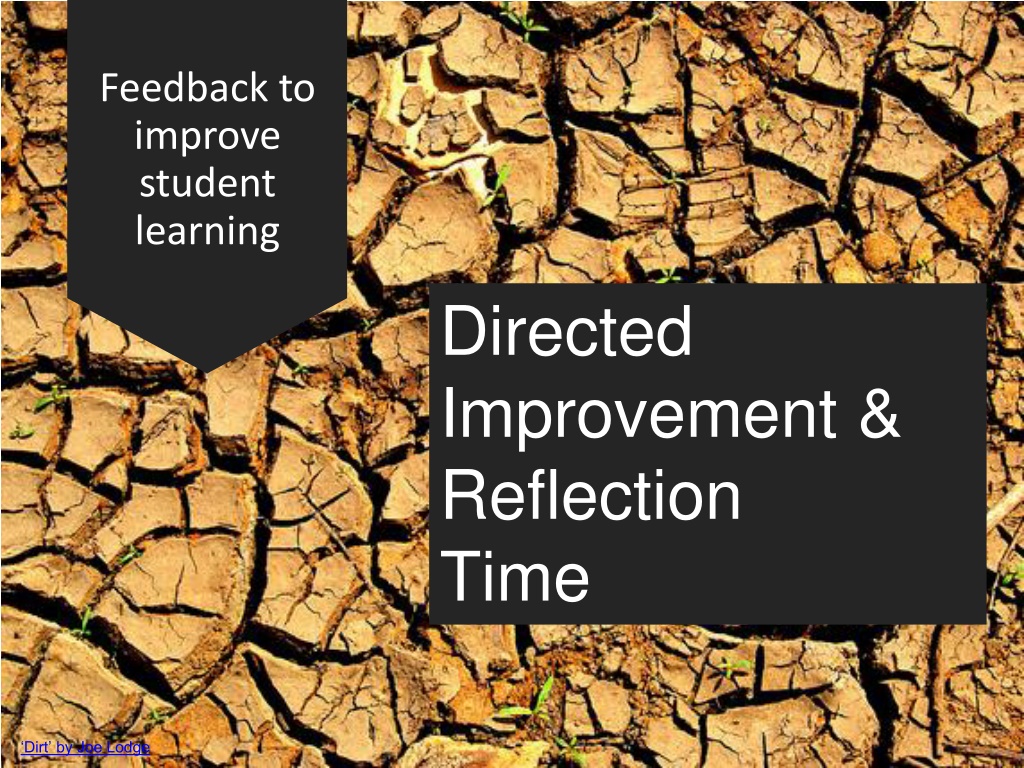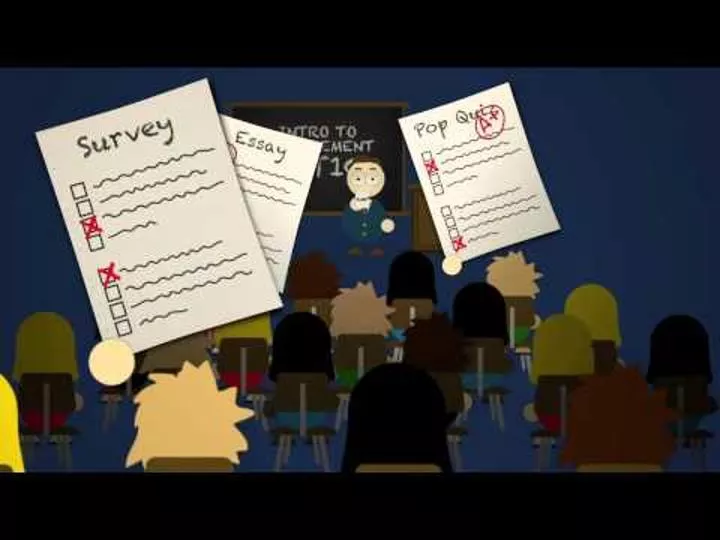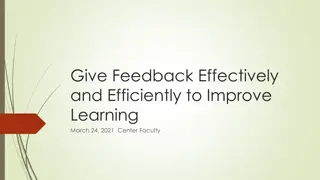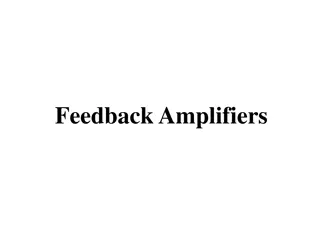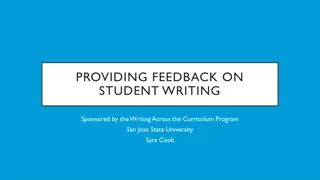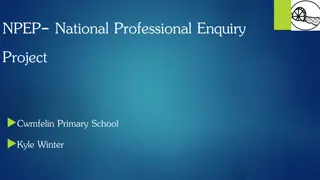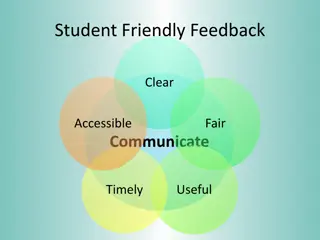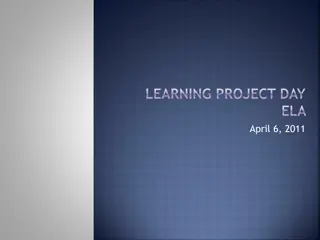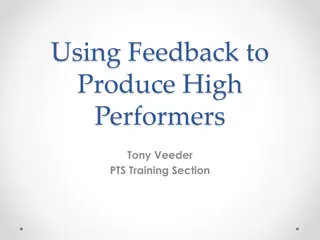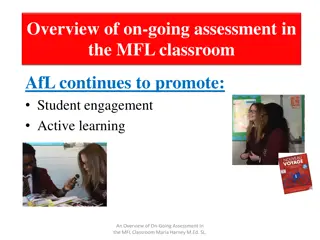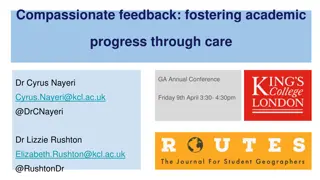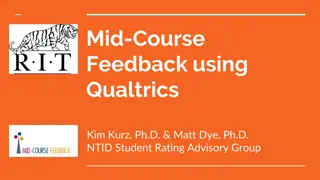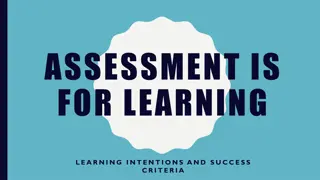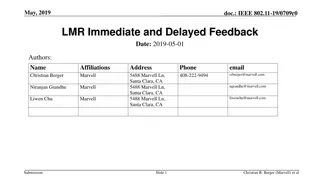Enhancing Student Learning Through Effective Feedback Strategies
Effective feedback plays a crucial role in improving student learning outcomes by providing specific information that students can use to enhance their performance. This content explores the importance of feedback, examples of good feedback practices, qualities of good feedback, and what components should be included in usable feedback for optimal results in student learning.
Download Presentation

Please find below an Image/Link to download the presentation.
The content on the website is provided AS IS for your information and personal use only. It may not be sold, licensed, or shared on other websites without obtaining consent from the author. Download presentation by click this link. If you encounter any issues during the download, it is possible that the publisher has removed the file from their server.
E N D
Presentation Transcript
Feedback to improve student learning Directed Improvement & Reflection Time Dirt by Joe Lodge
FEEDBACK Why bother when they just chuck it in the bin or ignore it and go straight to the mark?
What is feedback? Much of the research literature around formative assessment points to the importance of feedback to students as part of the learning process. Sadler (1989, 77) argues that formative assessment is "specifically intended to provide feedback on performance to improve and accelerate learning . Feedback is information provided to students that is used by them to alter the gap between their current performance and the ideal. If comments are not or cannot be used by students to alter the gap, then those comments do not constitute feedback!
Which are feedback? Which examples give better feedback than others? You have not put much effort into this , John. You will need to improve the structure of your exposition and work on the analysis section (H) of your WHY paragraphs before your final copy. Good work, Maddie. An interesting piece of research, but it needs a Bibliography. A lovely project but you haven t included information on all topics. Your opinion is clearly stated but you have not supported it with much factual data, nor have you used persuasive devices to sway your audience s opinions. 1. 2. 3. 4. 5.
What makes good feedback? It helps clarify what good performance is (goals, criteria, expected standards) facilitates the development of self-assessment (reflection) in learning delivers high quality information to students about their learning encourages teacher and peer dialogue around learning provides opportunities to close the gap between current and desired performance provides information to teachers that can be used to help shape future teaching
Usable feedback should contain: descriptions of the features of the students work (what has been done and/or not done) evaluative judgements/comments linked to criteria and standards that indicate the features of the work that add to or detract from its quality (how well things have been done) suggestions of alternative approaches that would lead to improvement explanations, or directions to resources, that demonstrate an improved possible approach that the student could use, and motivating comments (praise, encouragement etc.) that indicate that an aspect of the work is praiseworthy and explains why the element being praised is good.
Good feedback practices Write (handwritten) comments on students' essays, reports, etc. Use language at the student s level. Provide face-to-face feedback, where you discuss students' work with them, individually or in small groups. Email feedback on drafts directly to students. This can help ensure that the feedback is timely. Use model answers: these can show students a lot of detail which can be self-explanatory to them, allowing them to compare the model answers with their own work and see what they've missed out or got wrong.
Be specific about the type of feedback you are providing Comments should consider these five aspects: Structure: "Your abstract should be placed before your table of contents." Organisation: "Good problem statement. Where is your outline?" Language/punctuation: "(1) Word choice could be more accurate. (2) Start a new paragraph each time the speaker changes for dialogue." Conventions: "Which reference system are you using? Some of your references are inconsistent." Content: "The structure of materials, rationale, functions and operation is good, but there is no mention of the process you undertook to generate these ideas."
Getting students to make use of feedback Ensure that students and teachers have a shared understanding of what feedback is, and what it is for. Students may struggle to understand assessment criteria and the academic language used in feedback, so make sure you communicate clearly. Be explicit about the details of feedback processes and expectations. Ensure that students understand why they are getting feedback and how their learning can benefit from their reflecting, and acting, on feedback (Scott, 2008). Encourage and specifically teach self & peer editing.
The importance of DIRT "It cannot simply be assumed that when students are given feedback' they will know what to do with it" (Sadler, 1998, 78) D.I.R.T (yes another acronym sorry) DIRT stands for Dedicated Improvement and Reflection Time . The evidence about the importance of quality feedback is well founded. Put simply, feedback and DIRT are essential bedfellows. If we give great feedback, with specific targets to improve, then DIRT is the crucial next step to deal with that feedback.
Drafting, Feedback & DIRT Oral feedback is important too. Teacher or Peers read a draft of work, then give verbal feedback. Student then writes down the main points needed for improve- ment and begins to re-draft. This may be done more than once. Final (summative) marking should take into account how well they have acted on the feedback. You will need to teach Peer-editing Techniques to the class.
Modelling - Before, during or after. To develop an understanding of what is required regarding assessment and feedback, you can, for example: annotate and distribute a range of sample student responses on the same task to illustrate different levels of performance (high , middle, low) use annotated examples as a basis for class discussion let students undertake their own assessments of unannotated examples, justifying the kind of feedback and/or grades they would give, and perhaps annotating the examples for use in a future class
Engage students by getting them to Re-read their work and the feedback and write down 2 things they will focus on improving in their next piece of work. (Hand this in to the teacher who checks if they do.) Groups (high, mid, low) compare their work and feedback to the whole group on what aspects were needed to achieve higher marks and what was missing in lower responses. Give them feedback on (& maybe mark) drafts and get them to use this in improving the final product. Ensure marking guides include this aspect (for example. .. has considered feedback from draft and applied this to their work.)
Ensure consistency of feedback among teaching staff Hold a meeting with all teachers who will be marking assessments to agree on assessment criteria and feedback (type and level of detail). Provide markers and students with model student responses (high, mid, low) from a past assessment task to indicate what you are expecting, in terms of both structure and level of detail. Provide markers with a standardised marking criteria sheet with a rubric to indicate what is being marked and what constitutes a good, fair or poor answer.
Bibliography Dylan Wiliam: Feedback on learning: https://www.youtube.com/watch?v=n7Ox5aoZ4ww Feedback to improve student learning: http://www.flinders.edu.au/teaching/teaching- strategies/assessment/feedback/ Giving Assessment Feedback: http://teaching.unsw.edu.au/assessment- feedback Hunting English: http://www.huntingenglish.com/2013/10/12/dirty-work/ http://www.huntingenglish.com/2013/06/16/improving-written-feedback/ Peer Editing Symbols: http://mrssimonscy.wikispaces.com/file/view/Editing+Symbols.pdf Effective Feedback and Formative Assessment: http://www.youtube.com/watch?v=1Tihrg7nBos
